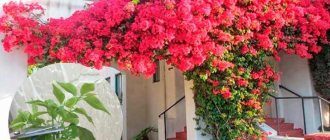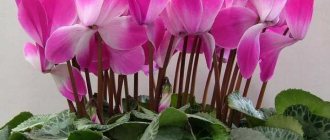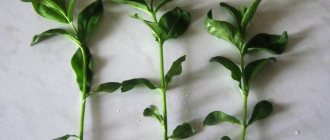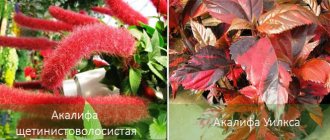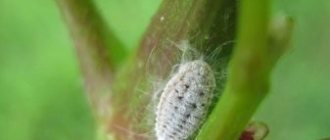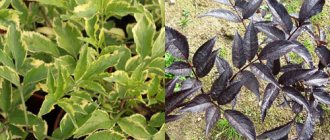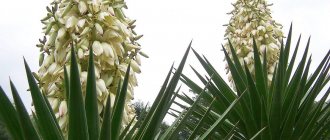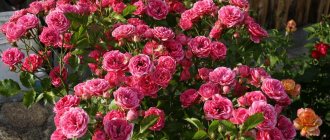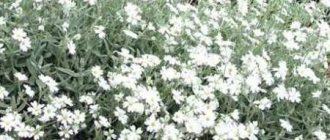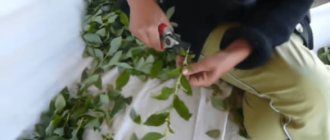Photo of bougainvillea bonsai Bougainvillea (Bougainvillea) – beautifully flowering evergreen plant from the Nyctaginaceae (Night-flowered) family. Low shrubs and vines with thorny shoots in their natural environment are common in the tropical regions of South Africa and Mexico, and the birthplace of bougainvillea is Brazil. In many countries it is grown as an indoor crop. At home, bougainvillea can live up to 10 years if wintering is properly organized. After this, the plant becomes woody and stops growing.
The flower grows at an average speed. It can grow up to 3 m if its development is not regulated and not trimmed in time. It blooms from mid-spring to early autumn with miniature cream flowers surrounded by bright original bracts. The plant is named in memory of the navigator Louis Antoine de Bougainville, who led the first French expedition around the world and brought a beautiful flower to Europe.
| Average growth rate. |
| Blooms in autumn, summer and spring. |
| The plant is grown with little difficulty. |
| Perennial. 8-10 years, if you keep a cool winter. |
Beneficial properties of bougainvillea
Flower cells secrete phytoncides - biologically active substances that cleanse the air space of harmful microorganisms. In rooms where the plant blooms, people's performance increases, anxiety levels decrease, and sleep improves. The flower attracts positive energy and generously shares it with others.
It is believed that bougainvillea helps to attract good luck and material well-being to all signs of the zodiac, only Sagittarius does not enjoy the favor of the plant. Blooming bougainvillea creates a pleasant atmosphere in the house.
Features of care at home. Briefly
The environment in which bougainvillea grows at home is different from the one to which it is accustomed in nature. But you also need to create a comfortable environment for the plant at home. The optimal conditions are:
| Temperature | In winter – from + 10° C, in summer – up to + 25° C. |
| Air humidity | Increased; placed on a tray with wet pebbles, sprayed between flowering intervals. |
| Lighting | Bright, does not need shading. |
| Watering | In summer – 2 times every 14 days, generously; in winter – once every 14 days. |
| Priming | Ready-made universal soil mixture for flowers; a mixture of 2 parts turf and leaf soil, 1 part humus and 1 part sand. |
| Feeding and fertilizer | From spring to autumn - once every 14 days - with concentrated liquid fertilizer for indoor flowers, diluted by half. |
| Transfer | Young bushes - annually; mature - after 2.5 years. |
| Reproduction | In spring - seeds and green cuttings; in autumn - semi-lignified cuttings; at any time - by air layering. |
The plant does not require special knowledge from the gardener in the field of biology, but it is necessary to take into account the peculiarities of growing bougainvillea, then it will be able to delight with its flowering several times a year.
The plant is conservative. Having got used to one place, it is difficult to get used to another. Therefore, you must immediately assign a certain place to the flower and not try to rearrange it. The plant is pruned several times a year to stimulate flowering (in summer), remove weak shoots and wilted inflorescences (in spring) , and to form a beautiful crown (in autumn). By shortening the branches, up to 10 cm of shoot of a given year is left on them. Pruning allows you to “play” with the shape of the plant. With this procedure, bougainvillea turns from a single-stemmed tree into a multi-stemmed shrub and vice versa.
Often a thorny vine is grown on a support, the shape of which can be any. Varieties of different colors grown in the same container look eccentric and elegant.
Home care
It is known that in its Brazilian homeland the flower does not have a dormant period and continuously grows and blooms at temperatures above 5 degrees. Below 5 gr. The plant may not be able to withstand the heat. In some subtropical regions of the Caucasus, Bougainvillea grows in open ground throughout the year, but even then we recommend covering it during a particularly critical time of year, in terms of temperature, for preventive purposes.

In central Russia, Bougainvillea is considered a plant of closed ground. It is grown exclusively in houses, greenhouses, and greenhouses. She needs space and bright light. Having adapted to new conditions of existence, where neither one nor the other is enough, she changed her habits - she does not bloom all year round without a break, and has a clear dormant period. With good care, it can please its owners with bright blooms several times a year. We will now tell you what is included in the concept of “good care”.
Location and temperature
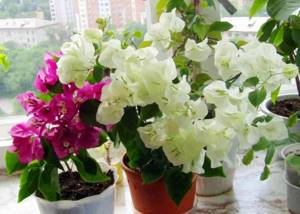
Bougainvillea should be placed on a southern or, at least, western windowsill, so that natural light from direct sunlight is at least 5 hours a day. Even from the midday sun you shouldn’t hide it. This is the main condition for its growth and intense coloring of the perianth during flowering. With a lack of light, the shoots begin to stretch, the foliage turns pale, and flowering stops.
The plant does not like drafts, but the room should be ventilated regularly. Make sure that air currents do not enter the plant.
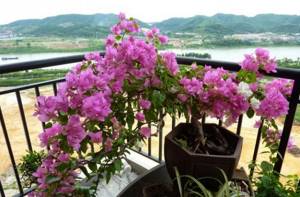
In warm summer months, it is useful to take the plant out into the garden, onto the veranda or open balcony. Find a place there, sheltered from wind and precipitation.
In winter, the flower will feel good on a glazed and well-insulated loggia, where there is bright lighting and the temperature does not drop below 10 degrees. heat.
Bougainvillea does not really like moving from place to place. Especially during the flowering period. A capricious beauty may be offended, especially if conditions change for the worse. The flower will shed not only flowers, but also leaves. If you return it to comfortable conditions with optimal temperature and lighting, after a short period of time the leaves will begin to grow again.
During the period of active plant growth, in spring and summer, the room temperature should be maintained within 22–25 degrees. During winter dormancy, it is advisable to reduce the temperature to 12–16 degrees. This must be done so that Bougainvillea forms as many flower buds as possible during this period, which will guarantee its abundant flowering in the spring. If you do not have the opportunity to keep it at low temperatures, then you will have to organize additional lighting for the flower using a phytolamp or a fluorescent lamp for up to 12 hours a day. Then Bougainvillea will not go into dormancy and will bloom weakly. But you won’t see lush blooms in summer either.
Air humidity
Bougainvillea loves high humidity. This should be achieved through regular spraying. During flowering, only the surrounding air should be sprayed, and it is better not to touch the flower itself, so as not to get the stream on the bracts. At other times, spraying Bougainvillea leaves, on both sides, will only benefit the flower. You can increase the humidity using a container of water placed near the flower pot, or place the pot itself in a tray on wet pebbles. Or you can buy a humidifier and use it.
Watering and spraying should be done only with soft, filtered, settled or boiled water.
Watering
Bougainvillea requires abundant watering during the period of active growth, in spring and summer. The substrate should be kept moist, but not wet. Water it after the top layer of soil is half dry. Usually this is once or twice a week. Pour water until it flows through the drainage holes and into the pan. It will not be amiss to remember that in nature the flower grows on the rocky soil of mountain slopes, and is not adapted to stagnant waterlogging - be sure to drain excess water from the pan.
In autumn, reduce watering; Bougainvillea should prepare for a dormant period. During hibernation, from November to February, watering is kept to a minimum. But the substrate should not be allowed to dry out completely. It is necessary to water once every 2-3 weeks. The cooler the air in the room, the less often you should water. If during winter dormancy the flower has dropped all its leaves, stop watering completely.
This may be interesting: Camellia in an apartment - growing and care
Top dressing
In order for the plant to grow well and bloom intensively, it should be fed properly. From early spring to mid-autumn it must be regularly fed with liquid fertilizers. Use fertilizers for flowering plants with a high content of phosphorus, potassium and iron. Such fertilizers promote the formation of a large number of buds and lush flowering. Excess nitrogen fertilizers weakens flowering.
Land for Bougainvillea
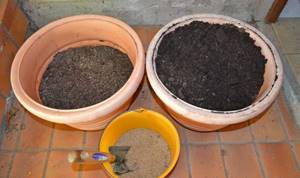
Bougainvillea loves nutritious but light soils with good moisture and breathability. Suitable universal soils for flowering indoor plants, with a pH of 5.5 - 6.0. But flower growers themselves are capable of preparing a substrate for it. To do this, take leaf and turf soil for 2 hours, and humus and coarse river sand for 1 hour. Add a little vermiculite, chalk, ash and pieces of charcoal to prevent fungal infections for looseness. All components must be steamed or spilled with boiling water to eliminate infections, viruses and parasites. Then the substrate is dried.
Pot
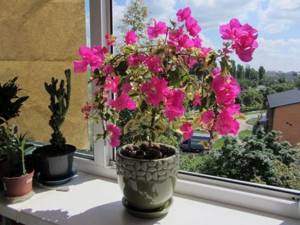
The pot for Bougainvillea should be chosen to be small, just a couple of cm larger than the old pot or earthen ball. If you immediately select a large pot, then in it the flower will intensively grow roots, and shoots will also grow - to the detriment of flowering. In addition, thin roots will not be able to quickly absorb a large volume of soil, which will lead to its souring. The height of the pot should be greater than its width. A good drainage layer, 3–4 cm, made of expanded clay, large pebbles or polystyrene foam should be laid at the bottom.
Transfer
At the beginning of spring, after winter dormancy, the flower awakens to active life. He is ready to grow green mass and root system again. This time is considered the most favorable for transplantation work. Young plants grow quickly. In a greenhouse, growth per year can be 3 meters. The larger the pot, the longer the flower branches will grow. And vice versa. In a cramped pot, growth will be minimal, but flowering will be more abundant. Young specimens are replanted annually to restore the nutritional value of the soil. Adults - once every 3-4 years, because they do not tolerate this procedure well.
Often, after transplantation, plants get sick, drop their leaves, and refuse to bloom. Therefore, in order not to damage the roots, do the replanting very carefully, by transferring the plant along with the earthen lump into a slightly larger pot. Do not bury the root collar. Fill the free space with new substrate, being careful not to compact it, but also not leaving voids in the pot. Water it. Keep the flower in partial shade for several days so that the root system gets used to the new substrate and takes root. Then put the pot in its place.
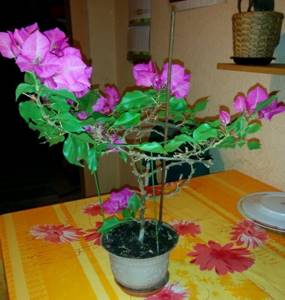
The flowering stems of mature Bougainvillea have a considerable weight. They need support. You will need a wire or bamboo support. For young bushes, a wire staple will be enough. It is bent in half, folded at the desired angle and stuck into the soil at the base of the flower.
Bloom
Bougainvillea has earned its popularity among flower growers precisely because of its magical flowering - bright and long-lasting. The formation of flower buds occurs in winter, and by May the whole plant turns into a huge bouquet, where, due to the blossoming inflorescences and bright bracts, no foliage is visible. The flowering period of domestic specimens can reach six to seven months - from May to November.
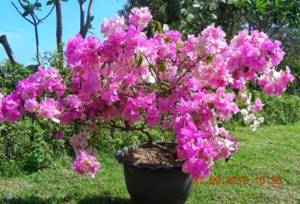
The color and shape of the bracts differ among different varieties of Bougainvillea. They come in pure white, pink, purple, violet, and lilac. Flower growers are especially delighted with varieties that are decorated with unusual double bracts arranged in several rows. Small cream flowers do not last long; they quickly wither and fall off. And the bracts stay on the branches for a long time, decorating the plant for six months. You can get acquainted with the most beautiful varieties of Bougainvillea here.
A pot with two different varieties of Bougainvillea, for example, with white and lilac bracts, looks decorative. Growing up, their trunks intertwine. During flowering, a lush white and lilac bouquet is obtained.
Trimming
Proper pruning is considered one of the main points when growing Bougainvillea. It is necessary both for the formation of the decorative appearance of the flower and for stimulating its flowering. Pruning is carried out several times a year.
- Spring pruning is carried out to remove weak, damaged or dried out branches from the plant over the winter.
- In summer, inflorescences that have lost their decorative effect are removed.
- In the fall, after flowering, Bougainvillea also needs to be pruned. When the bracts lose their decorative effect, its young shoots are shortened by a third of their length, leaving 6–8 buds on each. Excess young shoots that spoil the appearance are cut out to the trunk. It is better not to touch old branches, three years old or more - there will be no great effect, and the injury to the plant will be noticeable.
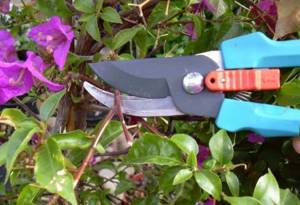
At the same time, before the onset of the dormant period, Bougainvillea is given the desired shape. You can form a flower in the form of a multi-stemmed bush. You can leave the shoots in the form of vines so that on the support you can give them any fancy shapes, for example, in the form of a heart or a ring. No less interesting are the compositions where Bougainvillea branches entwine figured frames, trellises and decorative latticework.
We draw your attention to the fact that during pruning it is necessary to leave a sufficient number of buds of the current year's young shoots, since dormant buds on old shoots awaken with difficulty, and you may be left without new shoots.
Bonsai
You can make a tree from Bougainvillea with one stem and several branches, in the form of a bonsai. How do they do it? Leave two or three selected branches on the plant, cut off the rest. This species is maintained for quite a long time until the plant becomes lignified. Then the central branches are radically pruned into a stump. They are waiting for Bougainvillea to produce new shoots - they should also be controlled in growth: remove the excess ones, pinch and trim the long ones, correct them with wire if they deviate from the desired direction. When the branches become woody in the desired position, the wire is removed.
We remind you that bonsai are formed before the dormant period begins, so that Bougainvillea has time to produce new shoots and lay flower buds on them. Then, next spring, your mini-tree will delight you with bright and lush flowering.
Sometimes bare branches at the bottom of a bonsai look unsightly. We recommend that you graft cuttings onto bald branches. To do this, cut a young green cutting from the crown of the flower and remove all the leaves from it. Just be careful not to damage the kidneys. Select a location on the branch for grafting. Take a drill with a suitable size drill bit, drill a hole and insert the handle into it. Treat the vaccination site with medical glue. Soon the grafting will take root, and the bonsai tree will take on a more elegant appearance.
This may be interesting: Tillandsia - home care
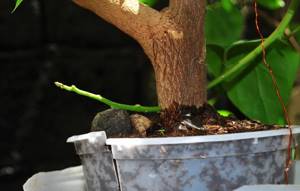
Insert the cutting into the hole in such a way as not to damage the buds, especially the one closest to the trunk. In the future, water the plant in a timely manner, do not move or disturb it, so as not to accidentally disturb the position of the grafted branches.
Caring for bougainvillea at home. Details
House bougainvillea is considered not a very fastidious plant. But you need to take care of the flower responsibly; the reward will be lush, long-lasting flowering.
Bloom
With good care at home, the plant begins to bloom at the end of April. This natural phenomenon has no equal in originality and brightness.
Therefore, bougainvillea is very popular among lovers of indoor flowers. Miniature cream flowers, collected in racemes, grow surrounded by bright bracts. Their texture is similar to crepe paper, from which needlewomen make flowers. In such a bright lilac, raspberry, pink or salmon “paper wrapper”, the flowers look like elegant bouquets decorated by a skillful florist. Bougainvillea is often called a paper plant, alluding to the similar texture of the bracts to paper.
Terry plant species, in which the bracts are arranged in several rows, look especially festive. The bracts, with their size, triangular, arrow-shaped or heart-shaped shape and brightness, cover the equally attractive oval leaves with a pointed end.
The flowers fade quickly, but the bracts retain their spectacular appearance for a long time. In order for the plant to bloom again, it is necessary to cut off the shoots when the bracts begin to dry out on them. In total, bougainvillea blooms at home for about six months.
Temperature
In order for bougainvillea to fully develop, care at home requires observance of the temperature regime. The plant is thermophilic. In winter, the room temperature must be maintained at + 10° C. If it is warmer, flower buds may not form. At temperatures below + 6°C the plant will die. In summer, the plant is comfortable at + 20 - 25° C.
Spraying
Bougainvillea prefers high humidity. Spraying is an important part of caring for a tropical plant. In order not to spoil the decorative appearance of the bracts, it is sprayed in between flowering periods. During flowering, air humidifiers are used, the plant is placed on a tray with wet pebbles, and an open vessel with water is placed next to it.
Lighting
As in the natural environment, the bougainvillea flower in indoor conditions loves bright lighting. Even on hot days the plant does not need shading. It will not bloom in poor light.
Bougainvillea should be kept in maximum bright light for up to 6 hours a day.
Watering
Bougainvillea loves to be watered abundantly .
Good care prevents stagnation of water. The soil must be kept moist. Watering in summer is required 2 times every 10 days. In the fall, when the plant is preparing to rest and begins to shed its leaves, reduce the number of waterings to once at the same time. In winter, water once every 14 days. For irrigation, use filtered water at room temperature. To keep the soil moist for a long time, it is mulched.
Priming
For planting, you can buy a ready-made universal substrate for flowers. You can prepare the soil mixture yourself from turf soil, leaf soil, perlite, humus (2: 2: 1: 1). Bougainvillea needs slightly acidic soil. To improve the composition of the substrate, you can add vermiculite, ash, and coal powder.
Additives will make the soil more loose and air- and water-permeable. The plant loves phosphorus fertilizers. Bone meal is added to the soil mixture as a slow-acting phosphate.
Feeding and fertilizer
Feeding and fertilizing helps to maintain the decorative quality of the plant at a high level. From mid-March to mid-September, water once every 14 days with a solution of concentrated fertilizer for house flowers, diluted by half. Only root feeding is carried out.
In winter, feeding is stopped.
Transfer
Young bushes are replanted annually in the spring. A mature plant will need to be repotted when the nutrients in the soil are depleted or when the bougainvillea outgrows the pot and its roots begin to peek out of the drainage holes.
This usually happens every 2.5 years. The plant has a hard time with replanting and expresses its dissatisfaction by dropping its foliage and refusing to bloom. After transplanting, provide your bougainvillea with special care. It is advisable to replant the flower; this method of replanting causes less stress on the plant. For transplantation, select a deep pot, the diameter of which is slightly larger than the previous one. There is no need to take a container that is too large: green mass will grow in it, and you may not wait for flowering. Removed from the old pot. Carefully inspect and slightly shorten the roots. The transplanted bougainvillea should be kept in a slightly shaded area without watering for several days. They begin to feed the plant 2.5 weeks after transplantation.
Caring for Bougainvillea at home
The shrub is unpretentious in care, but there are clear recommendations on this issue.
Location and temperature
In its homeland of Brazil, the plant comfortably tolerates temperatures from + 5 °C. In other conditions, bougainvillea dies. The subtropical zone of the Caucasus allows you to grow shrubs in open ground. In some cases, when it gets colder, it is covered with film for prevention.
Central Russia is a territory where shrubs are grown in closed ground conditions. These can be greenhouses or greenhouses. If living conditions allow, then the option of planting bougainvillea in your home is also possible.
Bougainvillea at home requires compliance with clear rules for caring for it.
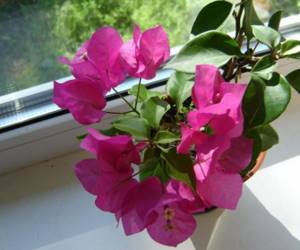
If you care for the plant correctly and provide it with growing conditions as close to natural as possible, then it can bloom several times during the year.
Creating natural light
In this case, a window sill on the south or west side of the home is suitable. Five hours a day is the maximum period for leaves and flowers to be exposed to direct sunlight. On a brightly lit afternoon, there is no need to hide the plant in the shade.
If this condition is not met, one cannot expect intense coloring of the perianths and their active growth. As a result, a lover of indoor greenery will receive a shrub with pale foliage and elongated shoots.
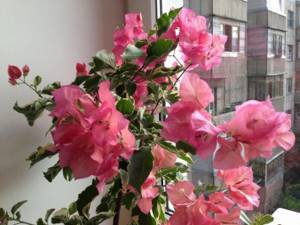
A window sill on the south or west side of the home is suitable for bougainvillea.
Draft protection
Bougainvillea does not tolerate them. This factor does not mean keeping the plant in conditions of complete lack of ventilation. The room where the bush is located should be regularly ventilated.
The main prohibition when ventilating it is that air flows do not enter the plant.
In warm weather, it is recommended to place it in an open area warmed by the sun, where there are no drafts.
Be careful when moving
Bougainvillea is a beauty with character, so it can be hostile to a sudden change of environment. During flowering, she will react especially sharply to other nuances of living. Under worse conditions, the shrub will say goodbye to its flowers and leaves. Then it can be restored if you return the bougainvillea to its comfortable zone.
Correct temperature
Spring and summer are the period when the room needs to be kept warm within 22-25 °C. During this time period, bougainvillea begins to actively grow.
In winter, it enters a dormant season, which requires a temperature of +12-16 °C. This reduction in heat in the room is necessary to create maximum conditions for the formation of buds.
In spring, bougainvillea will reward the care of the owner of the home with vigorous flowering.
If it is impossible to create such a temperature regime in winter, you can use a fluorescent lamp or phytolamp for additional lighting. The advantage of such a trick will be the imitation of artificial rest. Its disadvantage will be the weak flowering of bougainvillea in summer.
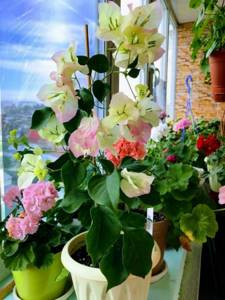
The room where the flower is located must be systematically ventilated, but be sure to protect the bush from drafts
Air humidity
The requirement of high humidity in the plant’s habitat is its small weakness. To create it, you need to regularly spray the bush. Soft, settled, filtered water is the ideal option in this case.
The correctness of spraying depends on timing indicators:
- Blooming season. During this period, it is not the bracts and leaves themselves that are sprayed, but the air surrounding them.
- Time to rest. The plant will appreciate being treated with water on both sides in its dormant state.
It doesn't hurt to use a container of liquid to increase the humidity in the bougainvillea's habitat. It is enough to place it next to the pot or use wet pebbles for the tray. If possible, it is recommended to purchase a humidifier.
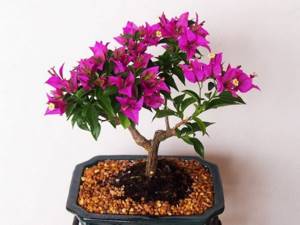
The crop needs high air humidity
Watering
Spring and summer are the time to water the plant abundantly. It is important not to overdo it in trying to moisten the soil. Repeated watering is carried out after half the top soil layer has dried.
It is recommended to perform the procedure 1-2 times a week as follows:
- pour water until it flows out of the drainage holes;
- remove excess moisture from the pan to avoid stagnation;
- repeat watering every week in summer and two weeks in autumn/winter.
Cool indoor temperatures mean less frequent irrigation of the soil. Watering is canceled if the plant has dropped its leaves at rest.
Top dressing
For this purpose, you need to purchase liquid fertilizers. Potassium-based products are useful. phosphorus and iron. They will give flowering plants the opportunity to form a large number of buds.
You should strictly follow the instructions for the drug. If there is an excess of nutrition, the shrub will not please with lush flowering.
Land for Bougainvillea
The soil for the plant should be nutritious and light in texture. Its air and moisture permeability is important. If we are talking about an indoor option, then it is better to opt for a universal soil. Its parameters must correspond to pH values from 5.5 to 6.0.
The substrate can actually be prepared at home. His recipe:
- Preparation of the composition. For it you will need to take 2 parts of turf and leaf soil, 1 part of coarse river sand and humus. The looseness of the composition and its ability to prevent fungal infections will be created by chalk, ash, vermiculite and a couple of pieces of charcoal.
- Steaming the substrate. It can be replaced by simply pouring boiling water over the mixture. This must be done in order to ultimately obtain a product that is free from viruses, parasites and infections.
- Drying the mixture. It is carried out by laying the substrate on a tarpaulin. It will be more convenient to use a special dryer.
Pot
A large pot is not suitable for placing plants in it for the first time. If you ignore this warning, the bougainvillea will grow roots at an accelerated rate. As a result, the shoots will also become more massive and interfere with flowering.
The thinness of the roots will not allow them to adapt to a large volume of soil, and they will sour. The width of the pot should exceed its height. Its bottom needs to be covered with a large layer of drainage. With a height of 3-4 cm, it should consist of polystyrene foam, expanded clay and large pebbles.
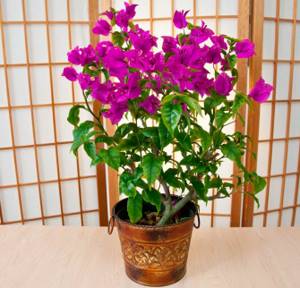
The container should be high, but not too wide
Replanting Bougainvillea
The active life of the plant begins in early spring. It was then that the time for transplantation work came. When young plants grow actively, their height in greenhouse conditions will be three meters. It still depends on the size of the pot which "controls" these parameters.
New specimens need to be replanted annually. Without such actions, the nutritional value of the soil is then difficult to restore. If the bougainvillea is already “adult”, the number of transplants should be reduced to once every 3-4 years. Otherwise, it will begin to hurt, will not bloom and will shed its leaves.
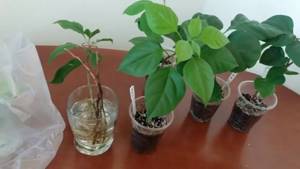
Replanting Bougainvillea
Rules for replanting a plant:
- Accuracy. To avoid damage to the roots, use the method of transferring an earthen clod along with the plant. For this, an additional and slightly larger pot will be useful.
- Correct placement. There is no need to deepen the root collar into the prepared soil. A new substrate will be needed to fill the resulting free space.
- Moderate compaction. It is not recommended to compact the soil too much. However, the presence of voids in the pot is unacceptable.
- Watering. There is no need to be zealous when irrigating. It is enough to water the transplanted plant moderately.
- Placement in partial shade. Two days are enough for bougainvillea to adapt to the new substrate. After the announced actions, the pot with the plant is returned to its original place.
Bougainvillea blooming
The bright and long-lasting fragrance of the inflorescences of this gift from tropical lands is its main trump card. Bougainvillea buds begin to form in winter. At the beginning of May they form an impressive bouquet.
Due to its lushness, the foliage is almost invisible. You can observe this flowering from May to December.
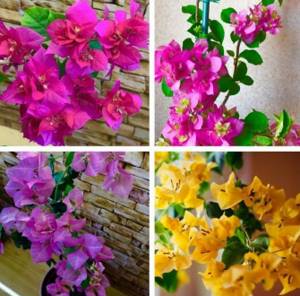
Trimming
The main factor in properly growing a plant is pruning according to the rules. Without it, giving the shrub a decorative appearance and promoting its flowering is impossible. Pruning a couple of times a year is enough to create the correct shape for the plant.
In the spring it is carried out to remove branches that have been damaged over the winter. In the summer, flower growers get rid of inflorescences that have lost their beautiful appearance. In autumn, the plant begins to prepare for the winter dormancy season.
Young shoots should be shortened by ⅓, taking into account the preservation of 6 to 8 buds on each of them. Sometimes you have to cut them down to the trunk if they cannot match the decorative appearance of the shrub.
Three-year-old and older shoots should not be touched because of the likelihood of damaging the plant.
What bougainvillea will look like in the future depends on the preferences of the grower. Options for the future form are a multi-stemmed bush, liana and bonsai. Then you can turn on your imagination and give the voiced outline even more interesting contours.
For lovers of exotic mini-trees, it is best to opt for the “bonsai” model. Bougainvillea with this shape is created in several stages:
- Primary pruning. With it, all branches are eliminated, except for two or three of the most successful ones.
- Observation period. You need to wait for the plant to lignify, which can take a long period of time.
- Cardinal circumcision. Its main purpose is to remove the branches in the center onto the stump.
- Repeated waiting. It lasts until the plant acquires new shoots.
- Control of shoots. It consists of pinching long ones, eliminating unnecessary ones and creating drainage for deviating shoots.
- Grafting cuttings. They do it on bald branches using a drill and then insert new material into the hole.
After grafting, the drilled area should be treated with medical glue for better engraftment.
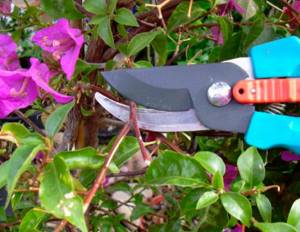
An important procedure when cultivating bougainvillea indoors is its pruning.
Bougainvillea propagation
Propagation of bougainvillea is possible in three ways: cuttings, air layering, and seeds.
Propagation by cuttings
Propagation by green (spring) or semi-lignified (autumn) cuttings. Cuttings must be at least 9 cm and have at least 3 buds. First, they are placed in a solution of a root growth stimulator, then rooted in a substrate at + 23 ° C and high humidity (covered with film, providing bottom heating). The film is removed to ventilate and water the seedlings. When the cuttings take root, they are planted in a small pot.
Reproduction by air layering
Conducted at any time of the year. Place a container filled with substrate next to the flowerpot in which the bougainvillea grows. A young thin shoot is tilted over the substrate and secured with a wooden pin. In the place where the shoot touches the ground, the plant is slightly warped to provoke root formation. After this, the shoot is sprinkled with earth, watered a little and mulched. When roots form, the seedling is cut off from the mother plant and planted in a separate pot.
Propagation by cuttings at home
In addition to seeds, the plant can be propagated by cuttings. It's better and more convenient. When cuttings, a new plant retains all varietal characteristics and blooms faster than propagation through seeds . A young bouquenvillea grown from a seed begins to bloom only in the 4th-5th year, while the cuttings will bloom in the second year.
For cuttings, select semi-lignified branches.
They are cut at the beginning of May and placed in water with a root growth stimulator for several days. Then the cuttings are planted in small pots and placed in a greenhouse, covered with polyethylene. The greenhouse is placed in a warm place with diffused sunlight. You need to water the cuttings as soon as the soil dries out. The greenhouse needs to be ventilated daily. Bougainvillea blooms very beautifully, but you need to create the necessary conditions for it.
Diseases and pests
Sometimes diseases appear from improper care of a flower, and pests cause harm to it. Most often, plant lovers have questions:
- bougainvillea leaves fall ? This may be caused by physiological reasons: the leaves become old and fall off, or the plant is preparing for winter. Summer leaf fall can occur from moving a flower from place to place or under the influence of a draft.
- Why do the leaves turn yellow (dry)? Most often, gardeners encounter this problem in winter if they over-moisten the soil.
- Why bougainvillea bloom? The problem could be caused by several reasons. Bougainvillea is located in a shaded area and receives little light. In winter the temperature was not lowered and flower buds could not form. Overfeeding with nitrogen also causes a lack of flowering.
Pests include: whitefly, spider mites, scale insects, aphids, mealybugs. Insecticides are used against insects.
Types and varieties of domestic bougainvillea with photos and names
There are about 15 plant species in nature, but only 3 of them are grown at home. All these species are native to Brazil: Bougainvillea Naked, Peruvian and Beautiful . At home, compact, low-growing species are popular, which are hybrid varieties created by breeders based on these species. They can be monochrome and two-color, variegated, changing colors, simple and terry.
Bougainvillea Double Pink
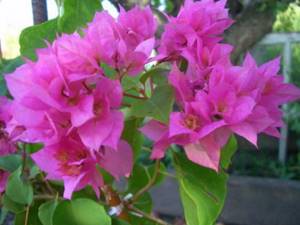
Terry bracts are colored soft pink with a greenish tint at the base. It is distinguished by its bright color throughout the entire flowering period.
Bougainvillea Thai Gold
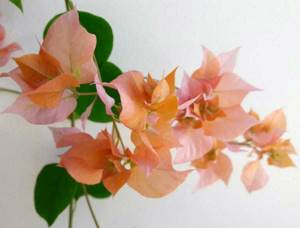
A variety that changes the color of its bracts during the growing season. At first they are painted golden with a bright orange tint. As they fade, they become bright pink with a slight blush.
Bougainvillea Alexandra / Bougainvillea Alexandra
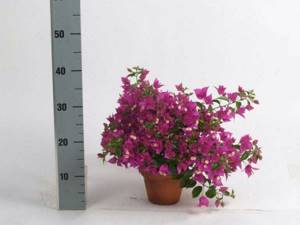
A very heat-loving variety with deep lilac bracts and small snow-white flowers, collected 2 - 3 pieces in racemose inflorescences. Does not tolerate even short-term drops in temperature. Designed for bonsai. With the help of pruning, plants create original compact compositions.
Bougainvillea is an unusual plant that combines tropical vibrancy and distinct French sophistication (the name obliges!). It will forever win the hearts of flora lovers and become the “highlight” of any interior.
